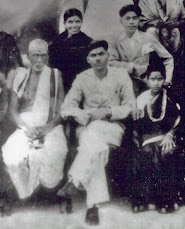Out of all his writings, if I were asked to choose only two papers which I consider as the most relevant for any student of Indian psychiatry I would name the following two. In my opinion, these two papers should be essential reading for any postgraduate student of psychiatry in India. These are:
1. "Some observations on the field of transcultural psychiatry" and "The structure in the Hindu joint family-some theoretical considerations.” This paper (which in fact are two related papers) was read by Dr. Surya at the conference on mental health in Asia and Pacific, March 28 to April 1, 1966 in Honolulu, Hawaii. Dr. Surya revised them and they were published in the proceedings of the conference.
2. A series of six lectures on Mental Health delivered by Dr. Surya as a part of post-graduate extension lectures for University of Mysore during 1965-67. First printed in "DHAMMA", journal of Mahabodhy Society, Bangalore in 1967. Later a slightly shortened version has been reproduced in the book "Aham" in 1993.
Surya’s views on Transcultural Psychiatry
During the 1950s there was growing interest in the subject of "Transcultural Psychiatry". How psychiatric symptoms and syndromes differ from culture to culture.
Do cultural factors modify psychiatric symptomatology? Is psychotherapy, as evolved in Europe and USA suitable and effective in other cultures? These were some of the questions being raised at many international forums (e.g. see WHO's I.P.S.S. 1973). Psychoanalytical theories were dominating the psychiatric scene and most of the cultural variations were explained on the model of Psychoanalytical theories, as was done, for example, in the anthropological writings of Margaret Mead(1935) and Ruth Benedict(1935). Very few Indian psychiatrists wrote on this subject and whenever they did it was usually an inadequate effort to apply psychoanalytical concepts to Indian situations.
Somewhere from mid-1960s, we see a significant emerging trend in Indian psychiatric writings of what one may call "Indianization of Psychiatry" (Wig & Akhtar 1974). Dr Surya, in many ways, was the forerunner of this trend. Many of us over the years, have lamented the inappropriateness of our psychiatric training abroad as a preparation for our work in India. See how beautifully Surya puts it in the introduction to his paper on Transcultural Psychiatry, in 1966: My basic medical training was in British India (1940). My medical practice was in the United Kingdom (1952-1958). When I returned to India I was faced with Indian psychiatric practice. Many of the concepts and terms I learned abroad in psychotherapy and interpersonal interaction seemed to make little impact. After considerable struggle with myself I located the difficulty-I was an Indian facing Indian patients and Indian situation but in dealing with this I was completely out of tune as I was applying totally different value systems, alien both to myself as well as to the patient."
Somewhere from mid-1960s, we see a significant emerging trend in Indian psychiatric writings of what one may call "Indianization of Psychiatry" (Wig & Akhtar 1974). Dr Surya, in many ways, was the forerunner of this trend. Many of us over the years, have lamented the inappropriateness of our psychiatric training abroad as a preparation for our work in India. See how beautifully Surya puts it in the introduction to his paper on Transcultural Psychiatry, in 1966: My basic medical training was in British India (1940). My medical practice was in the United Kingdom (1952-1958). When I returned to India I was faced with Indian psychiatric practice. Many of the concepts and terms I learned abroad in psychotherapy and interpersonal interaction seemed to make little impact. After considerable struggle with myself I located the difficulty-I was an Indian facing Indian patients and Indian situation but in dealing with this I was completely out of tune as I was applying totally different value systems, alien both to myself as well as to the patient."
When Surya wrote his paper, research in transcultural psychiatry was quite popular or one might say fashionable in international circles. One of the common methods used in transcultural epidemiological studies has been translation and back translation of research questionnaires by a bilingual research worker. In recent years such methods have been criticised by a number of anthropologically oriented psychiatrists (Kleinman 1986, Littlewood 1990). It is interesting to note that Surya had sensed the limitations of such methods of transcultural research earlier. In the same paper, in 1966, he writes :
"Most transcultural studies involve the use of questionnaires arrived at in a Western setting and sample areas of behaviour meaningful to them. Such questionnaires are then applied to a different culture. A concession to culture is made by conceding a translation, often laboriously arrived at. However, a mere translation does not solve the problems. For example, question on psycho-sexual maturity, management of hostility and so on. But, it is conceivable that a particular culture does not give the same emphasis or significance to this zone of behaviour. More damaging is the interpretation placed on such grafted questionnaires, either in terms of pathology or diagnosis". He continues in the same vein, a little further in the paper:
"The true value of transcultural studies will evade us if such studies were to occupy themselves with attempts to reduce all phenomena encountered to words and terms already accepted and familiar to us. This is very necessary, no doubt. But the qualitative richness of phenomena is lost if some energy were not expended in understanding the difference in the phenomenon encountered. In constructing or operating personality theories it is highly uneconomical and unproductive and even disadvantageous to start with well-developed concepts imported from outside and then to attempt laborious amendment and annotation. This does not touch even the fringe of the problem. One has not to neglect the theories of personality, one's own culture has accepted-one has to travel this road by intensive and extensive interaction with the people and then make the necessary amendments and deviations. The tardiness with which our (Indian) technologic leadership moves is because of this perpetual activity of amending borrowed conceptual plumes instead of walking, to say, with one's people before pretending to lead them".
In another place in the same paper he illustrates the limitations of the "objectivity" of perception in every culture with remarkable insight.
The adjective superstition is applied to beliefs that are not current in one's own culture. The fundamental, basic fact is based on omission and addition of objectively non-existent data. The respectable words 'selectivity' of ‘perception'; ‘mental set'; 'situational set'; anything but hallucination is used for this purpose. Each culture chooses its own areas of selectivity of perception and experience, and their own criteria of reality. Greater care is needed in using such words as superstition, hallucination, etc. in reference to cultures and people as a whole."











